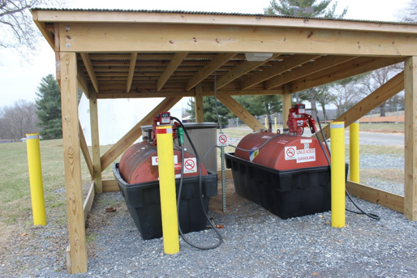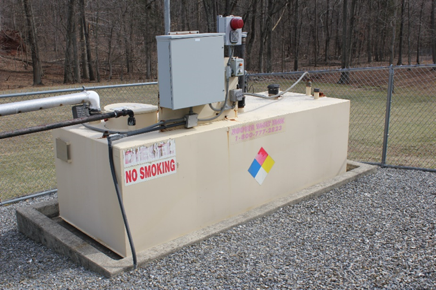The NIH Fuel Storage Tank Management Program is responsible for monitoring and maintaining the underground storage tanks (USTs) and aboveground storage tanks (ASTs) located on the NIH campus in Bethesda, MD and the NIH Animal Center in Poolesville, MD. There are 18 USTs and 66 ASTs (total capacity 1,309,687 gallons) located at the Bethesda campus; and there are 9 USTs and 27 ASTs (total capacity 158,783 gallons) located in Poolesville. All of the tanks are used for the storage of heating oil, gasoline, and diesel fuel. The tanks are routinely maintained through standard operational procedures, monitored monthly for release detection, and audited annually. UST System Compliance Inspection is executed by certified third party every three years.
The program’s objective is to maintain compliance with all legal and other requirements for fuel storage tank management and pollution prevention. The primary activities of this program include: proper filling and dispensing operations; proper operations and maintenance; monitoring systems; remedial maintenance; and tank installation and removal or replacement, if needed.
Tank Registration
All UST systems are required to be registered with Maryland Department of Environment (MDE) prior to tank installation and receive a Certificate of Registration. All AST systems must obtain a MDE Oil Operations Permit. The MDE Oil Control Program (OCP) reviews the permit application and schedules with the applicant to inspect the site. The MDE OCP issues or denies the permit.
Tank Inspections
Monthly and Annual UST System Walkthrough Inspections. The inspections consist of visual inspections of the following:
a) tank spill bucket and sump for liquid and debris (no water, product, or trash),
b) spill bucket and sump integrity (no cracks, bulges, or holes),
c) sump leak sensor (correct position and properly mounted),
d) fill pipe overfill prevention drop tube (operational and no observed obstructions),
e) Automatic Tank Gauge/Leak Detection Monitoring System (operational, normal, not in alarm),
f) flex connector piping (no leaks and no abnormal appearance or bulges),
g) fill pipe and monitoring well covers (tightly sealed, properly identified, and secure),
h) fuel dispensing UST inventory records (records completed daily and reconciled monthly), and
i) handheld release detection equipment inspection (gauge stick, ground water bailer, oil/water interface tape in good condition and functioning properly).
Monthly AST Inspections. The inspections consist of visual inspections of the following:
a) stability of tank foundation,
b) signs of rust and/or cracks,
c) area around valves and gauges free of drips; no leakage detected,
d) spill bucket free of liquid and debris (no water, product, or trash),
e) fill pipe overfill prevention drop tube (operational and no observed obstructions),
f) Automatic Tank Gauge/Leak Detection Monitoring System (operational, normal, not in alarm),
g) tank vent pipe unclogged,
h) tank leak detection alarm audible,
i) secondary containment is not cracked and supports 10% of the maximum volume of the tank.

Figure 1. Aboveground Storage Tank

Figure 2. Aboveground Storage Tank

Figure 3. Aboveground Storage Tank